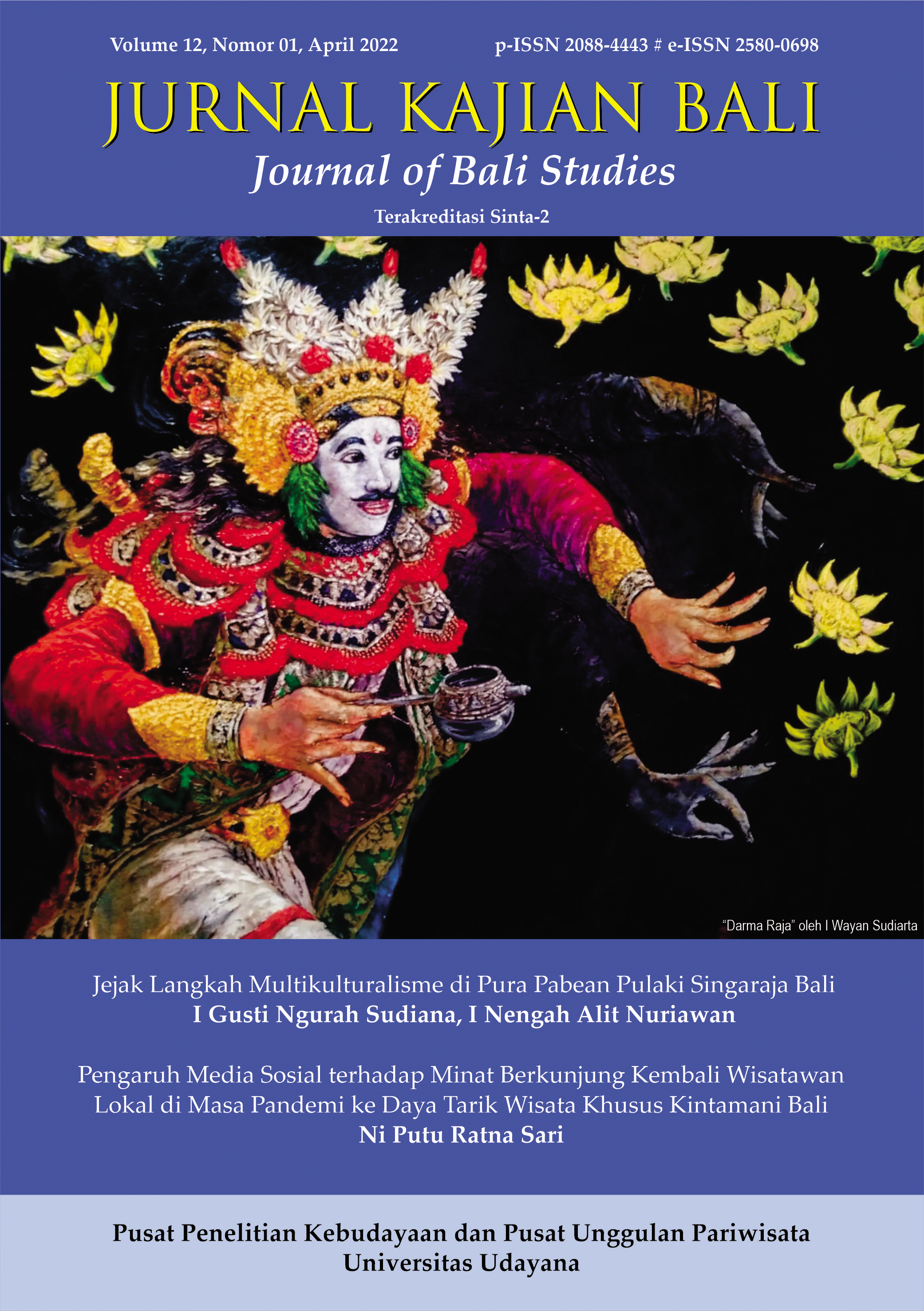Adat, People Power and Religious Values: Sources of Social Resilience from the Early to Middle 19th Century in Bali
English
Abstract
Adat and religious values played a significant role in the rise of social movements and people power during the Dutch colonial era which is evident in the dynamics of Bali in particular. For centuries, adat customary traditions had been deeply rooted in Balinese communities and strongly contributed to civilization and culture. However, certain factors, such as social, economic and political disturbances have threatened the stability of Balinese communities and culture. From the local perspective of Bali, this posed a threat against the sovereignty of the kingdom of Bali, was still recognized as an autonomous territory. In light of the above issues, this article used an interdisciplinary approach to historiography in analyzing oral history and textual archives. It is hoped to offer a better understanding of how historical Balinese adat and religious values fostered an increase in social resilience and people power when faced with externally generated disturbances.
Downloads
References
Ardhana, I Ketut. (1991). Kegagalan Misi Portugis di Bali Tahun 1653. Denpasar: Jurusan Sejarah Fakultas Sastra Universitas Udayana.
Ardhana, I Ketut. (2004 a.). “Puri dan Politik: Reformasi Nasional dan Dinamika Politik Regional Bali”, in I Nyoman Darma Putra (ed.). Bali Menuju Jagaditha: Aneka Perspektif. Denpasar: Pustaka Bali Post.
Ardhana, I Ketut. (2004 b.). “Kesadaran Kolektif Lokal dan Identitas Nasional dalam Proses Globalisasi” in Jurnal Politik Kebudayaan dan Identitas Etnik.pp.50-65.
Ardhana, I Ketut. (2005). Penataan Nusa Tenggara Pada Masa Kolonial 1915-1950. Jakarta: RajaGrafindo Persada.
Ardhana, I Ketut. (2013).”Pandangan Lokal versus Barat tentang Puputan Badung”, in Jurnal Kajian Bali, Vol. 03, Nomor. 01. pp.65-86.
Ardhana,I Ketut dkk. (2020). Pemetaan Tipologi dan Karakteristik Desa Adat di Bali. Denpasar: Cakra Media Utama.
Arsip Nasional Republik Indonesia. (1973). Ikhtisar keadaan politik Hindia-Belanda tahun 1839-1848. Jakarta: Arsip Nasional Republik Indonesia.
Dahm, Bernhard. (1971). History of Indonesia in the Twentieth Century. London/New York: Praeger.
Dwija Putra, I Dewa Alit Putra and Aditia, Patra. (2016). “Dutch Colonialism Symbols at the Reliefs on Jagaraga Temple, Northern Bali”. E-Proceedings The 3rd Bandung Creative Movement (BCM), Vol. 3, No. 1, pp. 331–337.
Gallagher, John and Robinson, Ronald. (1953). “The Imperialism of Free Trade, 1815-1914”, Economic History Review, 2nd ser., vol. IV (1953/54).
Geertz, Clifford. (1959). “Form and variation in Balinese village structure”. American Anthropologist, Vol. 61, No. 6, pp. 991–1012.
Geertz, Clifford. (1980). Negara: the theatre state in nineteenth-century Bali. Princeton: Princeton University Press.
Jacobs, Hubert S.J. (1984). “An Abortive Mission Effort: The Island of Bali in 1635”. Archivum Historicum Societatis Iesu, 53, pp. 313–330.
Jonge, J.K.J. de (ed.). (1865). De Opkomst van het Nederlandsch Gezag in Oost-Indie: Verzameling van Onuitgegeven Stukken uit het Oud-Koloniaale Archief, Vol. II. ‘s-Gravenhage-Amsterdam: Nijhoff.
Kartodirdjo, Sartono (ed.). (1973). Sejarah Perlawanan-Perlawanan Terhadap Kolonialisme. Jakarta: Departemen Pertahanan Pusat Sejarah ABRI.
Korn, V. E. (1922). Balische Overeenkomsten. ‘s-Gravenhage: Martinus Nijhoff.
Lekkerkerker, C. (1920). Bali en Lombok: Overzicht der Litteratuur omtrent deze Eilanden tot Einde 1919. Rijswijk: Blankwaardt & Schoonhoven.
Lekkerkerker, C. (1923). Het Voorspel der Vestiging van de Nederlandsche Macht op Bali en Lombok. Bijdragen tot de Taal-, Land-, en Volkenkunde 79, pp. 198–322.
Leur, J.C. van. (1940). “Enige aanteekeningen betreffende de mogelijkheid der 18e eeuw als categorie in de Indische geschiedschrijving’. Tijdschrift voor Indische Taal-, Land- en Volkenkunde 80: 544–568.
Manan, Putri Rezki (2020).” People Power dalam Suksesi Kepemimpinan di Mesir.” In Wanua: Jurnal Hubungan Internasional Departemen Ilmu Hubungan Internasional Universitas Hasanuddin Volume 5 No. 1. Juni 2020 https://journal.unhas.ac.id/index.php/wanua/article/view/14072 pp. 73- 92.
Pageh, I Made. (2019). “Perang Puputan Jagaraga dalam Perspektif Bela Negara”. Paper presented at the Historical Lecture at the Monumen Perang Puputan Jagaraga, 29 May.
Parimartha, I Gde. (2011). “Aktualisasi Nilai-nilai “Puputan” dalam Pembangunan Karakter Bangsa”, in Jurnal Kajian Bali, Vol. 01, Nomor, 02. pp.123-139
Sastrodiwiryo, Soegianto. (1994). Perang Jagaraga (1846-1849): Kisah Heroik Patih Jelantik dari Bali dalam Melawan Tentara Kolonial Belanda di Abad ke-XIX. Denpasar: Kayumas Agung.
Soehartono. (1973). “Perang Jagaraga”, in Sartono Kartodirdjo (ed.). Sejarah Perlawanan-Perlawanan Terhadap Kolonialisme. Jakarta: Departemen Pertahanan Keamanan Pusat Sejarah ABRI.
Ricklefs,M.C,dkk.(2013). Sejarah Asia Tenggara: Dari Masa Prasejarah sampai Kontemporer. Depok: Tim Komunitas Bambu.
Slamet,Y. (2006). Metode Penelitian Sosial.Surakarta:LPP UNS dan UNS Press.
Stuart-Fox, David J. [2002]. (2010). Pura Besakih: temple, religion and society in Bali [Pura Besakih: Pura, Agama dan Masyarakat Bali], trans. Ida Bagus Putra Yadnya. Denpasar: Pustaka Larasan & Udayana University Press; Jakarta: KITLV Press.
Weitzel, A. W. P. [1850]. (1859). De Derde Militaire Expeditie naar het eiland Bali, in 1849. Gorinchem: J. Noorduyn en Zoon.

This work is licensed under a Creative Commons Attribution 4.0 International License.



















